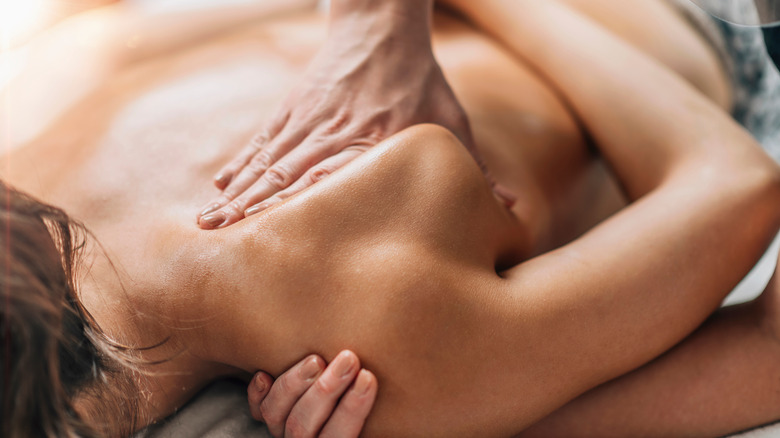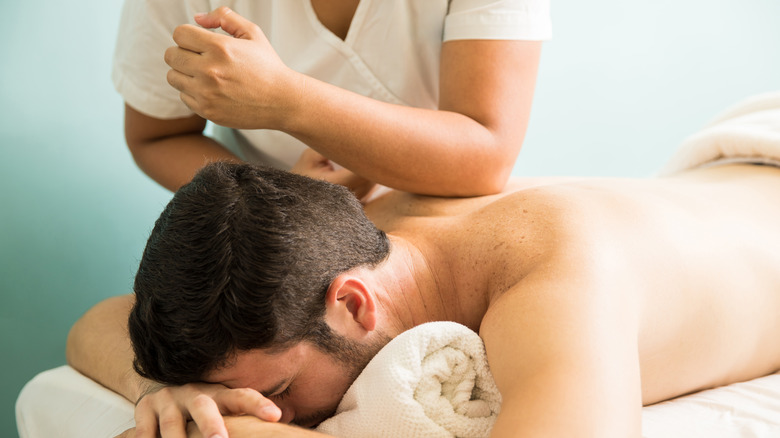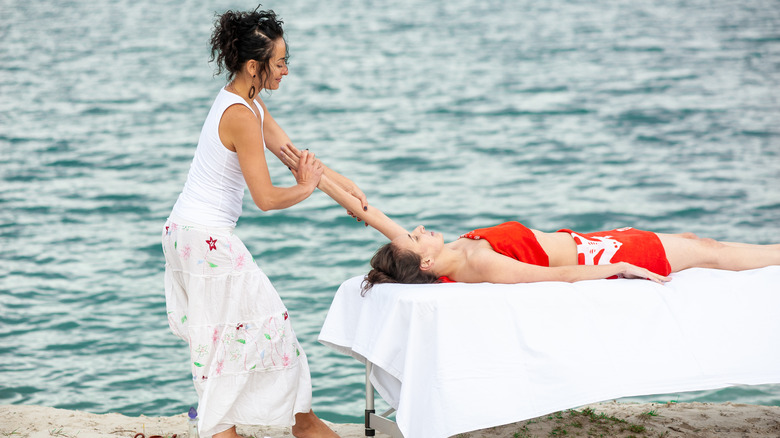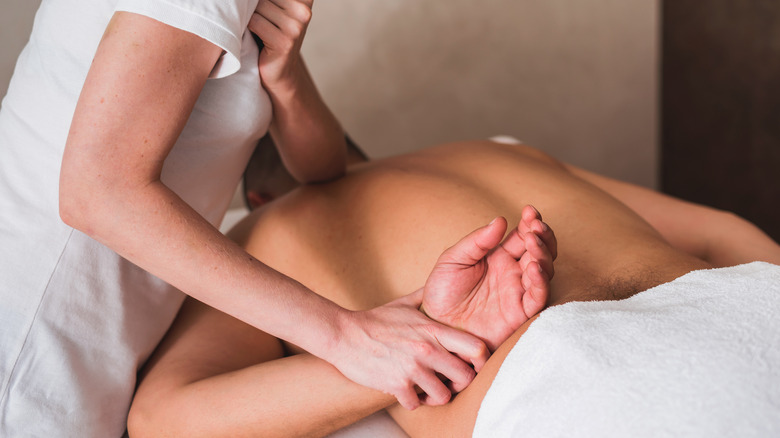What You Need To Know Before Getting A Lomi Lomi Massage
From hot stone massage to a hammam bubble massage, there's a range of different massage types, all with different purported benefits. Although comprehensive research on massage is still needed, the Mayo Clinic says massage can improve relaxation, circulation, and immune function, and may reduce stress, muscle soreness, and blood pressure. One unique type of massage with a deep cultural history is the lomi lomi (or lomilomi) massage.
The word lomi, according to the Manomano Hawaiian dictionary, means "To rub, press, squeeze, crush, mash fine, knead, massage, rub out; to work in and out, as claws of a contented cat." Lomi lomi massage traces its roots to ancient Polynesia, and it was brought by them to the Hawaiian islands. More than just a relaxation technique, traditional lomi lomi massage is performed by spiritual healers, and is used in connection with other healing practices, including Ho'oponopono and Lā'au lapa'au.
The Native Hawaiian Health Care System states that Ho'oponopono is used "to address conflicts within families and communities," whereas Lā'au lapa'au is "pule" or prayer alongside the use of "Native Hawaiian plant medicine for healing purposes." These healing techniques, including lomi lomi massage, were practiced and taught by elders (Kapuna), who passed them down to both family members and students. But despite their roots in Hawaiian culture, these healing practices — lomi lomi massage, in particular — have been the subject of much debate.
The great debate over lomi lomi massage
In 1998, the Hawaii state legislature passed Act 162, which granted sole licensing authority "for practitioners of traditional native Hawaiian healing arts" to Papa Ola Lōkahi, a kapuna council that was meant to "[establish] a certification system for traditional native Hawaiian healers." According to Pacific Business News, the law was intended to keep regulation of these traditional healing practices, including lomi lomi, in the hands of elders, not the government — as well as "to keep inexperienced 'New Age' people from claiming they were Native Hawaiian healers."
Since the passage of the law, however, the state has made additional attempts to establish its own certification boards, which the Papa Ola Lōkahi vehemently opposes. To make matters surrounding lomi lomi even more confusing, Hawaii state law includes the practice in its list of massage therapy services that require state licensure to operate. The kapuna council also opposes this, with one representative addressing the state board of massage therapy to claim this licensure requirement is "unconstitutional" and allows licensed massage therapists to "[misrepresent] themselves and [defraud] customers."
One board member put it even more plainly, stating that some lomi lomi customers could simply be getting "a glorified Swedish massage and don't know any better." This, of course, begs the question: How do you know if you're getting a traditional lomi lomi treatment?
Where can you find a traditional lomi lomi practitioner?
One of the kapuna councils tasked with designating certifications for practices like lomi lomi has done its work, according to the Hawaii state legislature. The Waianae Community Kupuna Council not only oversees such a certification process, but it also helps direct the work of The Waianae Coast Comprehensive Health Center, which takes a "holistic approach to health care" by "[providing] accessible, quality, and affordable, comprehensive health care, while preserving native Hawaiian culture and traditions in order to achieve complete wellness."
This means that those in search of kapuna council-certified practitioners do have ways to figure out if they're getting the real deal, even amid what seems like a sea of lomi lomi practitioners at resorts and spas nationwide. But even if you don't secure authentication, you should reasonably expect most of the traditional techniques of lomi lomi to remain intact, regardless of where you book your massage.
Lomi lomi involves different parts of the body massaged at once
The lomi lomi massage will likely start in silence, with a silent prayer or setting of an intention for the healing that's about to happen (per Aloha International).
Using long flowing movements and the forearms as well as the hands is one of the signature elements to a lomi lomi massage; the practitioner might even use their elbows, knees, and feet, and according to Carisma Spa, different parts of the body will be massaged at the same time instead of focusing on one part at a time. It might also include humming and chanting (per Nalu Massage Training).
Traditionally, it was done with little or no clothes on, but it's likely that in more modern spas, a towel will be used for modesty, like you might expect during other massages (via Massage by Pro).
For lomi lomi practitioners, they are likely to be able to trace the heritage of the style they practice. Since it was practiced in different villages and passed down generation to generation, each area and teacher had its own style. So each treatment might be different depending on the practitioner and your needs in that moment. But no matter what with a lomi lomi massage, you should leave feeling relaxed and at peace and connected to an ancient tradition.



